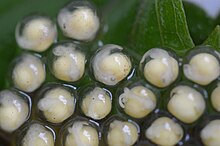Raorchestes jayarami
| Jayaram's bush frog | |
|---|---|

| |
| Male Jayaram's bush frog calling | |
| Scientific classification | |
| Domain: | Eukaryota |
| Kingdom: | Animalia |
| Phylum: | Chordata |
| Class: | Amphibia |
| Order: | Anura |
| Family: | Rhacophoridae |
| Genus: | Raorchestes |
| Species: | R. jayarami
|
| Binomial name | |
| Raorchestes jayarami (Biju & Bossuyt, 2009)
| |
| Synonyms | |
| |


Raorchestes jayarami, also known as Jayaram's bush frog, is a species of frog from the subfamily rhacophoridae found in Valparai in the Western Ghats of Tamil Nadu in India, where it has been observed between 600 and 1800 meters above sea level.[2][3][4][1]
Appearance[edit]
Individuals of this species from the genus Raorchestes have morphs that range from plain green to variations with splotches and dots of darker greens and in some cases yellow.[5] Anuran's from the genus Raorchestes, show direct-development while allows them to be independent from a waterbody for the development of tadpoles.[5]
Habitat[edit]
This frog has been observed inhabiting small patches of forest and shola in between human settlements. There have been a few sightings on tea plantations.[1]
Threats[edit]
Scientists classify this frog is endangered because of its small, heavily fragmented range. Its habitat is subject to deforestation associated with logging and agriculture. Parts of the frog's habitat in the Western Ghats is the site of an annual pilgrimage. These visitors disturb the frog and burn grassland to create space.
Scientists also name climate change as a threat to this species. Given that the populations live at high elevations, they cannot simply migrate north if their range should warm.[1]
This frog is occasionally used in traditional medicine for children's coughs, inability to speak, and inability to walk.[1]
Scientists have observed the fungus Batrachochytrium dendrobatidis on other frogs in Raorchestes, so they believe it can infect R. jayarami as well. Batrachochytrium dendrobatidis causes the fungal disease chytridiomycosis.[1]
References[edit]
- ^ a b c d e f IUCN SSC Amphibian Specialist Group. (2023). "Raorchestes jayarami". IUCN Red List of Threatened Species. 2023: e.T186162A1810810. doi:10.2305/IUCN.UK.2023-1.RLTS.T186162A1810810.en.
- ^ Frost, Darrel R. (2014). "Raorchestes jayarami (Biju and Bossuyt, 2009)". Amphibian Species of the World: an Online Reference. Version 6.0. American Museum of Natural History. Retrieved 25 September 2014.
- ^ "Raorchestes jayarami (Biju and Bossuyt, 2009)". AmphibiaWeb. University of California, Berkeley. Retrieved 28 August 2023.
- ^ Biju, S. D.; Bossuyt, Franky (2009). "Systematics and phylogeny of Philautus Gistel, 1848 (Anura, Rhacophoridae) in the Western Ghats of India, with descriptions of 12 new species". Zoological Journal of the Linnean Society. 155 (2): 374–444. doi:10.1111/j.1096-3642.2008.00466.x.
- ^ a b Vijayakumar, S. P.; Dinesh, K. P.; Prabhu, Mrugank V.; Shanker, Kartik (10 December 2014). "Lineage delimitation and description of nine new species of bush frogs (Anura: Raorchestes , Rhacophoridae) from the Western Ghats Escarpment". Zootaxa. 3893 (4): 451–488. doi:10.11646/zootaxa.3893.4.1. ISSN 1175-5334. PMID 25544534. S2CID 46572350.
External links[edit]
 Data related to Raorchestes jayarami at Wikispecies
Data related to Raorchestes jayarami at Wikispecies

